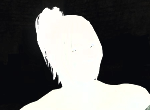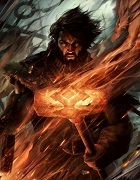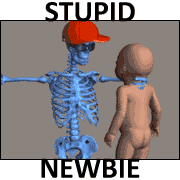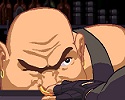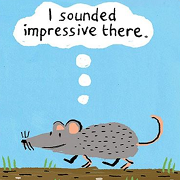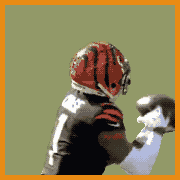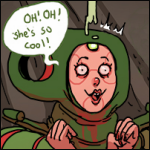|
sebmojo posted:Do you think oots has good characterisation? Absurd Alhazred posted:What does that have to do with alignment?
|
|
|
|

|
| # ? May 25, 2024 09:41 |
|
NGDBSS posted:The whole point is that alignment isn't good characterization. OOTS isn't using alignment for characterization. It may have done some of that to begin with, when it was a gag-a-day strip about breaking the fourth wall in a D&D
|
|
|
|
If anything, OotS takes a stand against alignment based characterisation. Evil people can love and have trusted friends whose loss they mourn (Tarquin and company) while Good people can be assholes (Eugene and Miko). Play your character, not your alignment.
|
|
|
|
|
THE BAR posted:Remember the rage when they changed it in 4e? To be fair, they made it even more oversimplified and reductionist. They weren't exactly acknowledging the complexities of moral outlooks.
|
|
|
|
Absurd Alhazred posted:OOTS isn't using alignment for characterization. It may have done some of that to begin with, when it was a gag-a-day strip about breaking the fourth wall in a D&D It does though? Thor flies past a literal copy of the alignment grid with durkon and minrah. Belkars move away from CE is a significant plot element. Roys alignment behaviour is discussed explicitly when he dies. Characters aren't alignment robots, but picture each character, idk, filling out their taxes. Does your mental picture align exactly with their alignment?
|
|
|
|
ikanreed posted:To be fair, they made it even more oversimplified and reductionist. They weren't exactly acknowledging the complexities of moral outlooks. It made sense from a tabletop gameplay perspective, but as with most things in 4e, it didn't help the actual roleplaying much.
|
|
|
|
Absurd Alhazred posted:OOTS isn't using alignment for characterization. It may have done some of that to begin with, when it was a gag-a-day strip about breaking the fourth wall in a D&D
|
|
|
|
NGDBSS posted:I agree with you, I'm just gobsmacked at sebmojo equating the two when as you've noted the strip moved on over a thousand strips ago.
|
|
|
|
NGDBSS posted:I agree with you, I'm just gobsmacked at sebmojo equating the two when as you've noted the strip moved on over a thousand strips ago. It hasn't, he constantly uses alignment as a tool for characterisation and narrative. The Empire of Blood is lawful evil and that's integral to the points he makes about civility not being a virtue in itself.
|
|
|
|
sebmojo posted:It hasn't, he constantly uses alignment as a tool for characterisation and narrative. The Empire of Blood is lawful evil and that's integral to the points he makes about civility not being a virtue in itself. Or the Empire of Blood is shown to be civil and yet commit atrocities, demonstrating that civility isn't a virtue by itself. See how I described things that happen in a world involving people engaging with other people and their values without using alignments? You can, too!
|
|
|
|
this is a very, hmm  INTJ conversation to have INTJ conversation to have
|
|
|
|
Now how does layering Planescape's philosophical faction system onto all this affect things?
|
|
|
|
sebmojo posted:It does though? You can view Belkar's development as moving away from Chaotic Evil -- or you can view it as a hosed-up and emotionally stunted selfish rear end in a top hat learning to be a better person through the connections he builds to his friends. But also, one of the points that the plot has hammered home again and again is that viewing the world purely through alignment-tinted goggles is a really good way to get blindsided by the richness and complexity of human experience. It gets Durkon murdered by Malack, it causes Miko to fall, it's what leads the Sapphire Guard down the campaign of genocide that makes Redcloak into who he is. Alignment is a force in OOTS in the same way that, say, countries are a fact of life in our world. Some people strongly identify with one and let it inform their entire personality, some people reject the concept entirely, most are somewhere in between, but while one thing you can't do is pretend they don't exist at all, it's equally silly to assume that where a person lives is going to completely define their personality. I think that's the best way to handle alignment in D&D, if you must include it at all: treat it like an external force that tries to impose its will on humanity, rather than the actual cause of human behaviour.
|
|
|
|
Or, just treat it as a pair of personality traits that do not inform literally everything a person does. Like, two people can be sociable, but one gets really bashful if they're the center of attention, and one gets really lovely and unpleasant if they feel wronged. That doesn't mean they're not both sociable, that just means the word "sociable" is not some kind of absolute state of being. E: It is also a metaphysical force in the setting itself, granted, but if you're working with that you should have it act through agents like extraplanar beings or evil priests or something. Zulily Zoetrope fucked around with this message at 21:58 on Mar 18, 2021 |
|
|
|
*checks notes* Ok, so next is Goblins chat, right?
|
|
|
|
Whybird posted:You can view Belkar's development as moving away from Chaotic Evil -- or you can view it as a hosed-up and emotionally stunted selfish rear end in a top hat learning to be a better person through the connections he builds to his friends. Yeah, of course. It's good character development. I'd just argue that the ridiculous, clunky, nerdy, arbitary alignment grid is a tool that helped burlew produce that development rather than hindered it (which includes the points you note about miko, the SG and Redcloak). Any character is going to have a couple of core tensions, internal/external structures (C/L) and altruism/selfishness (G/E) is not a terrible way of framing that, regardless of what you call them. I wouldn't use alignment in my games, or in my own writing, but I think if you assume it's always worthless then you need to find a way to exclude OOTS because it's baked into it. 
|
|
|
|
"How can this be bad if it helped inspire this media I like!?!?  " isn't the gotcha you think it is. " isn't the gotcha you think it is.
|
|
|
|
SKULL.GIF posted:I always figured alignment was closer to the right here than it is on the left: Yeah, that's another thing some other sources do better. To use SMT again, humans are by default Neutral on the Law-Chaos axis because Law and Chaos both generally require commitment and clear principles, or at least very consistent behavior; just having a preference for authority or anti-establishment isn't enough. Robin Hood, the go-to CG example in D&D, would in my opinion actually be a good example of how someone could be Neutral because they have clear principles rather than because they lack them; he opposes unjust authorities and steals from the rich despite theft society regarding theft as wrong, but instead of personal gain or to oppose authority in principle, he's doing it to support and raise up the poor and downtrodden and fight their exploitation. (Plus, he pals around with less-awful kings and such sometimes.) Firm principles and decisive action, isn't dedicated to order or chaos and just takes what it feels is best from both. (This is also an example of how most pro-human positions tend to be Neutral in SMT; you generally have to value some principle or other thing a lot more than you value people, or value certain people (even if that's just yourself) a lot more than the well-being of people in general, to really be Lawful or Chaotic there.) Though, writing this and some stuff I later erased out made me realize something. Systems like this usually don't differentiate between neutral by default and neutral as a matter of actual principle or rejection of the other options, even though they often treat them differently or even rely on that difference. To use SMT again, while humans in general are the former, the protagonist of a Neutral route and usually some allies or NPCs are very firmly the latter, and have to be to do the kind of things they do. But in that case they're often usually acting on behalf of the former, caring more about their general well-being and freedom than the extreme principles presented by the two sides, both of which would victimize them in some manner, so you can't entirely separate them either. Personally if I'm differentiating the two in a discussion I use neutral vs Neutral for the former and latter respectively, since it's a simple way of getting the idea across, (and sometimes the same for "decent person" good versus "paragon, saintly, or literally an angel" Good, etc) but in a more formal or official context that feels like it'd be inadequate. (Heck, even D&D has done this despite having nine different alignments to work with, as some editions outright admit to lumping together "neutral by default"/uncommited and "neutral through actively and intentionally balancing good, evil, law, and chaos (whether in themselves or the world as the whole)", and possibly "incapable of ethical considerations because they're an animal or something", despite them being very different from each other, arguably even moreso than they are from some of the other alignments.) Zulily Zoetrope posted:Or, just treat it as a pair of personality traits that do not inform literally everything a person does. Like, two people can be sociable, but one gets really bashful if they're the center of attention, and one gets really lovely and unpleasant if they feel wronged. That doesn't mean they're not both sociable, that just means the word "sociable" is not some kind of absolute state of being. At that point there's no reason to have it be a formal thing at all really. Which, well, personally I think leaving out alignment entirely unless you have a specific reason to use it would be good for RPGs in general, but the conversation is more about when you are using it. Roland Jones fucked around with this message at 22:32 on Mar 18, 2021 |
|
|
|
sebmojo posted:It hasn't, he constantly uses alignment as a tool for characterisation and narrative. The Empire of Blood is lawful evil and that's integral to the points he makes about civility not being a virtue in itself. Yeah, I feel like people claiming the comic has long ago moved on from alignment are just telling on themselves. It still brings it up constantly and characters' alignments inform their personalities. It is a world in which alignment is baked into existence; it hasn't decided to throw Smite Evil in the bin or anything. If you think OotS has good characterization, then you agree that alignment can be done (in a story, not necessarily a tabletop game) in a way that doesn't stifle the characters and make them boring or stupid.
|
|
|
|
Roland Jones posted:At that point there's no reason to have it be a formal thing at all really. Which, well, personally I think leaving out alignment entirely unless you have a specific reason to use it would be good for RPGs in general, but the conversation is more about when you are using it. There are systems which allow you for a more interesting and productive way of formalized characterization, like Aspects in Fate, or HX (history with other characters) in Apocalypse World. It's a false dichotomy.
|
|
|
|
I mean Burlew is aware of and has referenced TVTropes but I would be very confused by anyone saying that specific website is integral to the comic's story, even though the things it covers are even more present in the generic self-aware high fantasy stick figure comic strip
|
|
|
|
Roland Jones posted:At that point there's no reason to have it be a formal thing at all really. Which, well, personally I think leaving out alignment entirely unless you have a specific reason to use it would be good for RPGs in general, but the conversation is more about when you are using it. Oh, agreed. I think the lesson I'd take from oots is that it's useful to have an ethical structure in your head when you're writing, it matters less exactly what it is. That said it's imo a bit obtuse to ignore the influence of the gygax grid on what he's created. For gaming, it's mostly worthless because everyone's gonna have a different structure in their own head.
|
|
|
|
Lt. Danger posted:I mean Burlew is aware of and has referenced TVTropes but I would be very confused by anyone saying that specific website is integral to the comic's story, even though the things it covers are even more present in the generic self-aware high fantasy stick figure comic strip I would be very confused by that too because Burlew's story isn't set in a parody of TVTropes. Nor have tropes been directly referenced by name in the comics multiple times.
|
|
|
|
I feel like the internal logic of "trying to do good" doesn't really hold up with a lot of characters, because a lot of driven people believe that they're doing good despite doing terrible things. Or they believe that they're only doing what's good for themselves and not minding others and if they get hurt by getting in the way, that's their fault. Apathy can be incredibly harmful. So either you develop some kind of internal logic as to what ideologies count as evil, or alignment is more of a judgement externally (which could be useful for the collaborative storytelling aspect of tabletop RPGs when some people may not be too clear on who's good or who's bad). Either way it feels kinda clumsy. At first glance it feels like alignment should be significant to the inner driving force of a character, but actually it's only loosely informative to their relation to the outside world. Which is why I really like 13th age's Icon system where instead of the cosmological judgement of moral alignment, it's basically a non-ideological measurement of their political stance by what institutions from the most important ones around the world they feel connected to or obligated to or repulsed by, and that's a thing that can more directly come into the story and have an impact on the game as opposed to something off to the side that at best is only ever tangentially relevant.
|
|
|
|
Cup Runneth Over posted:I would be very confused by that too because Burlew's story isn't set in a parody of TVTropes. 
|
|
|
|
I should point out that Lampshade Hanging is an actual storytelling term. Berlew was actually not aware of TV Tropes for a good chunk of the comic.
|
|
|
|
Burlew uses tropes, because tropes are common descriptors of storytelling devices. They're a thing that exists independently of tvtropes dot org.
|
|
|
Absurd Alhazred posted:There are systems which allow you for a more interesting and productive way of formalized characterization, like Aspects in Fate, or HX (history with other characters) in Apocalypse World. It's a false dichotomy. Sure, other systems might do it better. But D&D 3.5 alignment does allow that kind of formalized characterization and can add value - it's not a useless or meaningless tool, and it does add a layer beyond not having a system at all. And it's the most examined and used one (see how we're still talking about how 3.5 does it and not 4e or 5e) because it does have some interesting nuance beyond a good/evil slider like 4e, which is boring and just gets ignored.
|
|
|
|
|
Nothingtoseehere posted:Sure, other systems might do it better. But D&D 3.5 alignment does allow that kind of formalized characterization and can add value - it's not a useless or meaningless tool, and it does add a layer beyond not having a system at all. And it's the most examined and used one (see how we're still talking about how 3.5 does it and not 4e or 5e) because it does have some interesting nuance beyond a good/evil slider like 4e, which is boring and just gets ignored. Two meaningless dimensions instead of one isn't nuance.
|
|
|
I dunno, we're still arguing over it. If it wasn't a hard question, we'd have agreement about what they meant. Just because you don't think those dimensions add nuance doesn't mean others don'tsebmojo posted:
|
|
|
|
|
Nothingtoseehere posted:I dunno, we're still arguing over it. If it wasn't a hard question, we'd have agreement about what they meant. Just because you don't think those dimensions add nuance doesn't mean others don't If it wasn't a hard question, goons wouldn't be arguing about it? That's your angle? Are you new to the forums?
|
|
|
|
The Alignment Chart is a core part of OotS's universe, but it doesn't really dictate the characterization as in so much as it seems to be a reference thing? It's almost an algorithm, considering Roy having to argue in favor of his original placement.
|
|
|
|
Oh poo poo Sereni heel turn
|
|
|
|
Can Alignment Charts Be Used For a Story? Yes. Literally anything can be used and used well in a way that enhances the work, given the correct handling. Must Alignment Charts Be Used For a Story? No. See above. As for whether they can/must be used in games, I'll leave it to the folks whose DnD knowledge is independent of a humorous stick figure comic, but I suspect the answers are the same.
|
|
|
|
LOL at the people so poisoned by the dumbness of the alignment system that they can't accept anything good can be made that actively engages in/with the alignment system. I dunno what to say, it's pretty damned clear Burlew's been using the alignment system to inform the characters and the world- how "good" is defined in a D&D sense is a huge part of why we're at the endgame we're at! But he's definitely not using it, no sir, because nothing good can come out of the alignment system, and the characterization of OOTS is good, ergo it did not come from the alignment system. QED, duh, you're a dummy if you think otherwise and if you disagree it's just because goons will argue about anything. Now, if you'll excuse me, I have to run in a circle and say I'm proving something.
|
|
|
|
the entire like arc of the comic is about how the alignment system is too rigid and simplistic for a narrative. which i guess ironically means that yes, its essential to the story if only to subvert it
|
|
|
|
Back when I used to post on the WotC forums in the days of 3.5, alignment debates would get so heated that there were in-jokes to get people to shut up and move onto something productive. No one could agree what the alignment axes meant besides their relation to a couple spells and abilities. Some people would even come up with their own variant alignment charts (eg the MtG color wheel) and offer explanations of what those meant. So no, even in the 3.5 days alignment was not a good tool for characterization.mandatory lesbian posted:the entire like arc of the comic is about how the alignment system is too rigid and simplistic for a narrative. which i guess ironically means that yes, its essential to the story if only to subvert it 
|
|
|
|
Absurd Alhazred posted:There are systems which allow you for a more interesting and productive way of formalized characterization, like Aspects in Fate, or HX (history with other characters) in Apocalypse World. It's a false dichotomy. Oh, yeah, I am familiar with those, and like both of those systems more than D&D in general. It's not "alignment" then though, it's, well, what you just said. Assuming you have something mechanical behind them at least; I interpreted the post I was responding to as reducing the Lawful-Chaotic and Good-Evil axes to just being a couple of descriptors you write on your sheet, with no actual in-game effects or anything. At that point it seems like you're just keeping alignment around for the sake of having it, which addresses some of the issues discussed here but not others, including the one you brought up, that alignment pushes people to think in its terms. PbtA games, among others I've seen, show that there is value to having some purely descriptive, non-mechanical entries on a character sheet for players to fill in or pick from, I'm not objecting to that concept or anything, but if you want to do that then I think you'd be much better off not limiting the options there to D&D's 3x3 grid. Absurd Alhazred posted:Two meaningless dimensions instead of one isn't nuance. Honestly, with the benefit of hindsight I think the second dimension probably actually made things worse for D&D in the long run. Gygax's initial resistance to adding the Good-Evil axis was the right call (though him having Law basically be synonymous with Good and Chaos effectively be Evil, with most humans explicitly being Lawful if I am remembering what I read correctly, was less good), since you can generally categorize things into "Lawful" and "Chaotic" (or neither) with minimal confusion, as long as you're consistent on what those two terms mean at least (something D&D has not succeeded in). Provided people aren't using different definitions, there shouldn't be many problems, and both concepts also easily lend to being used as big cosmic forces or whatever in-universe. One side is ordered, stable, rigid, sterile, stifling, tyrannical, etc, and the other is flexible, creative, messy, destructive, inconsistent, overwhelming, and so on. You ask people to imagine forces of Law and Chaos, and they'll mostly end up in the right place pretty easily. Good and Evil, though, are something people will disagree on a lot more, and have been disagreeing on for millennia of human history. It gets even worse when you have them as actual forces in universe, since that makes objective Good and Evil part of the game itself, bringing the above issue into it and making it something very likely come up when playing, instead of just a thing people disagree about when checking the labels they put on each other's character sheets. Making them more specific concepts or philosophies, even if they're still "the good one" and "the bad one" basically, could work better (while accomplishing more or less the same thing if you have to go that way), but literally going, "This is what Good is, and this is what Evil is," is just asking for trouble.
|
|
|
|
Serini's plan for dealing with the entire Order is to ask them their opinions on the alignment system, thereby distracting them long enough for Xykon to seize control of the Gate and render the whole thing moot.
|
|
|
|

|
| # ? May 25, 2024 09:41 |
|
I guess another reason to not frame the current conflict in terms of alignment is that there are 4 different evil groups who had schemes involving the gate with differing ideas of what to do. Xykon and Redcloak want to harvest the gate to rule the world or threaten the gods respectively, Nale wanted to steal that plan and somehow do it himself, the evil directorate wanted to destroy the gates for whatever reason, and Tarquin was mostly ambivalent but figured that he might as well destroy the gate so nobody else could use it. And then Hel I guess wanted to use the threat of the gates to unmake the world, but I don't think she gets anything if the gates break and the dwarves don't get cashed out.
|
|
|



